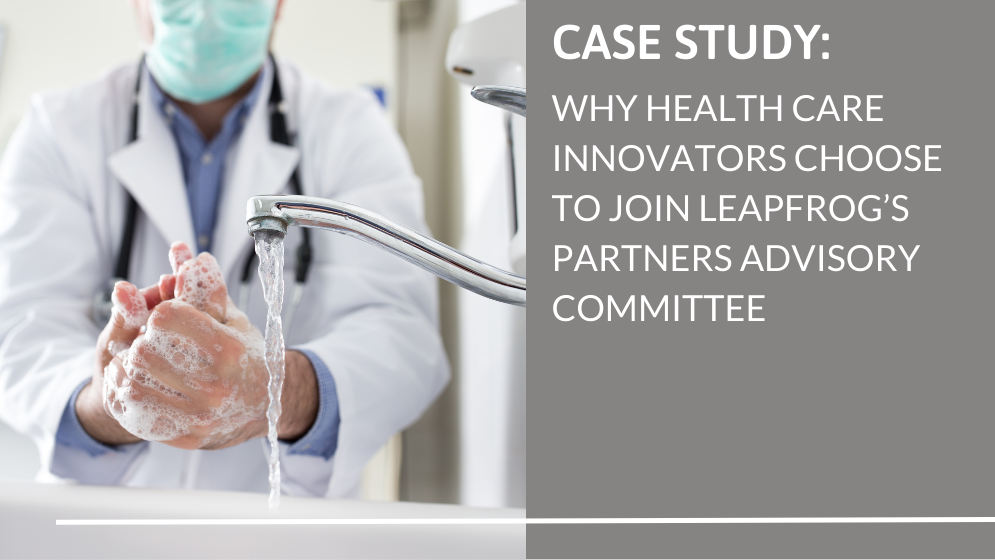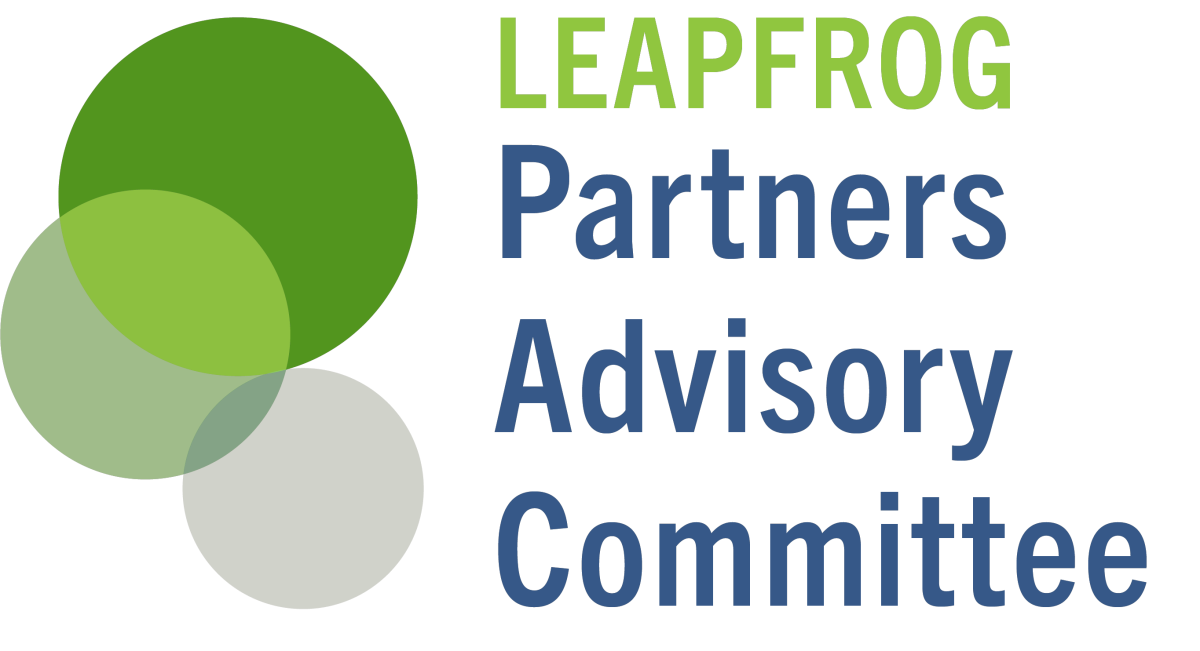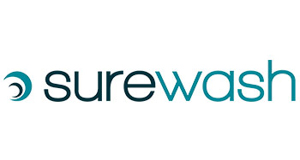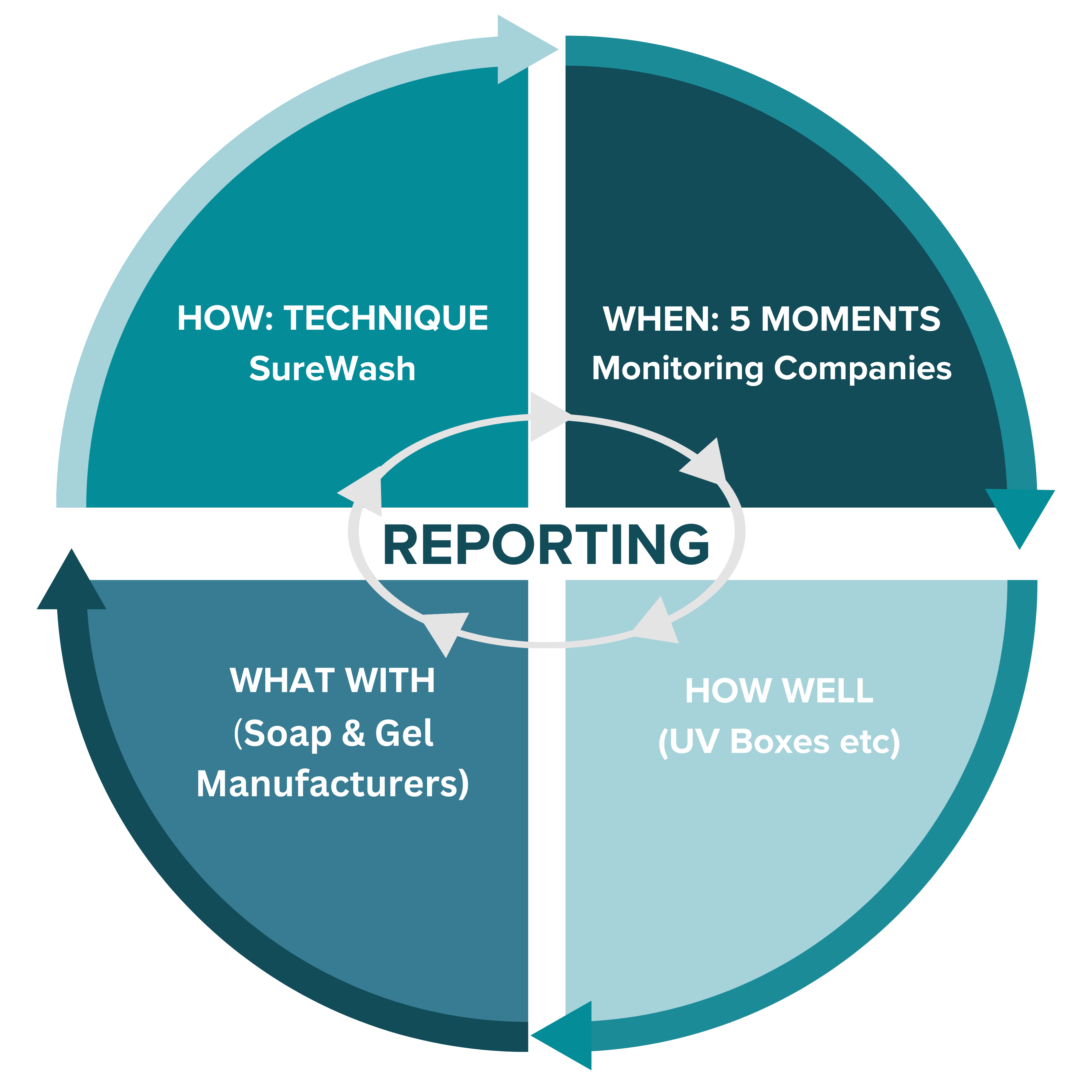
About The Leapfrog Partners Advisory Committee
The Partners Advisory Committee was established in 2009 to give health care companies a structured interactive forum for dialogue between the industry and Leapfrog’s Management and Board of Directors.
The Committee meets on a quarterly basis with members coming together twice a year via teleconference and twice a year in‐person in conjunction with the Leapfrog Board of Directors meetings. The Committee makes regular reports to Leapfrog’s Board of Directors on the Committee’s membership, proposals, and progress. It also serves as a platform for the creation, implementation, and evaluation of new partner‐driven initiatives that promote our shared vision and mission.

About SureWash
Based out of the Trinity Technology and Enterprise center in Dublin, Ireland, SureWash has gone from strength to strength over the last 10 years. Their hand hygiene training technology is innovative and unique to the market, combining leading-edge technology with enhanced gamification learning techniques. Their technology solves the problem of delivering hand hygiene training and has been validated in scientific studies as an effective tool to increase hand hygiene compliance and improve hand hygiene culture as part of a multimodal approach.

Leapfrog Director of Employer & Payor Engagement, Jill Berger, interviewed Cecil Ryan, Executive Chairman, and Danielle Nolan, Marketing Manager of SureWash about their work on patient safety and why they have chosen to support the Leapfrog Group.
Q: Can you tell us about the history of SureWash? What patient safety problem was SureWash invented to solve?
A: After the SARS Outbreak of 2009, hand hygiene was identified as a critically important challenge in health care. With this new focus, we realized that hand hygiene was still being taught the same way as it was 30-40 years ago. Professor Gerry Lacey our founder, invented a computer vision system to solve the problem and incorporated a learning methodology derived from his considerable experience as an educator. The inclusion of gamification was the final element and resulted in a training system that has proven to be both effective and attractive to employees. We created a way to practice, get instant feedback and allow trainees to gain competency.
Hand hygiene is a psycho-motor skill much like tying your shoes. You need to practice, rest, repeat and get feedback. The study by researchers at Yale School of Medicine and Trinity College Dublin that we shared for Leapfrog’s newsletter found that the average student took 32 hand hygiene exercises with feedback, delivered over 5 days, to achieve proficiency and unconscious competence.
Q: What makes SureWash’s solution unique and/or innovative?
A: We have a patent on the use of cameras for providing feedback on the quality of one’s handwashing. We are the only company that has been using cameras to provide feedback in this way.
Traditionally, glow boxes were used in training where one would simulate washing their hands with a powder and then stick their hands under a UV light to see where they missed. This approach tells people what they got wrong but doesn’t help them learn the proper technique.
In recent years we’ve added a wider educational focus with our quizzes and lessons features that aim to teach trainees when they need to wash their hands and why it is important, plus some basic PPE and infection control education. We also have a reporting suite that creates specific reports for hospitals to answer the questions in Leapfrog’s hand hygiene standards. SureWash allows them to train and assess their staff and then SureWash.Net provides a snapshot of how the facility is doing.
Q: And why is supporting patient safety important to your organization?
A: It’s the entire reason we are founded. We have one focus: to train people on hand hygiene technique and knowledge with the goal of improving the standards for our various customers, primarily health care facilities. It’s not just for healthcare workers, it can and maybe should be used by patients and visitors so that everyone understands they have a role in patient safety.
Q: What made you interested in joining the PAC?
A: We are based in Ireland and don’t spend a lot of time physically in the United States. We originally came across Leapfrog through our customers in the States who had questions about how our product matched Leapfrog’s standards. The PAC helps us significantly with understanding the market in the United States and connecting us with the various companies that provide monitoring technology in the health care field. The PAC provides us with an opportunity to network, gain market knowledge and help us understand where things are headed in the United States.
There is a benefit to being able to say we are Leapfrog PAC members because it shows we are embedded in the patient safety field in the US. We have the example of CHRISTUS Mother Frances Hospital – Sulphur Springs in Texas which recently gained funding for the SureWash GO unit through individual donors and a grant from the CHRISTUS Foundation. They have expressed how they want to use it for training and educating new employees but also for their annual hand hygiene training for all employees. The hospital specifically said that it would help them achieve the Leapfrog hand hygiene standard and allow them to better serve their patients.
"We originally came across Leapfrog through our customers in the States who had questions about how our product matched Leapfrog’s standards...The PAC helps us significantly with understanding the market in the United States."
Q: We appreciate your newsletter submission and excellent webinar. Can you tell us about the process of preparing for that? How did you choose your topic?
A: The process was pretty seamless. The newsletter used a paper from researchers at Yale School of Medicine and Trinity College Dublin about training proficiency in hand hygiene technique based on WHO standards and using a SureWash GO unit as a simulator. We primarily wanted to get our data and research to a broader audience. The data is quite interesting to people in quality and infection preventionists as it shows that current training methods just aren’t sufficient.
Regarding the webinar, we wanted to show our expertise in the hand hygiene space from a technology research perspective but also show some real-life experience. Based on the feedback we got and the interactions in the chat it seemed to go really well. It was a great opportunity and there were maybe 300 quality, senior infection preventionists. We got quite a few questions on the nitty-gritty details of our technology.
Q: How has the newsletter article and webinar affected your business?
A: We got some calls after the newsletter, the chat in the webinar actually helped us learn a lot about what kind of questions potential customers have. We noticed that some of the people who attended the webinar were people we had spoken to in the past and wanted to learn more about our technology. We are now having more conversations on a network level while before it would have been an individual IP that would contact us interested in our product but now we have a different market position.
Q: How does the Leapfrog partnership work with your other marketing?
A: We talk about Leapfrog all the time when working in the United States, it has redefined our messaging. It adds an extra dimension when you’re talking to potential customers. All of our business in the United has a Leapfrog focus. Additionally, we do lots of trade shows and we have people come up to our booth and talk to us because of Leapfrog specifically. We were disappointed with our attempts with print media campaigns in the past but it is something we are more hopeful about and looking into more now because of the Leapfrog dimension.
"All of our business in the United has a Leapfrog focus... it has redefined our messaging."
Q: What has been your experience attending the in-person and virtual PAC meetings? And what connection have you made?
A: They’ve been really good. They have a very open and friendly atmosphere. We’ve made great connections with other suppliers and have gotten close to the Leapfrog team. It gives us an opportunity to have lots of side chats with other health care monitoring companies.
Q: Is there anything else you would like to share?
A: We want to reiterate our new message that we can help hospitals with meeting Leapfrog standards and that there should be a focus on “training before you monitor”. There is a lot of attention on monitoring when people wash their hands. As a rough guide, the electronic systems that measure this are about 10x the cost of SureWash. Training is extremely important for health care: we don’t give physicians a needle and tell them to place sutures and we’ll check to see how they do afterward. We train them first.
"We don’t give physicians a needle and tell them to place sutures and we’ll check to see how they do afterward; We train them first."
If I am a hospital, I have to talk to one company about monitoring, one about gel, one about measuring, one about the dispensers. Hospitals should be asking for a holistic solution on hand hygiene that covers the when, the how, the how well and the what with? SureWash plays a very important role in what we refer to as the Hand Hygiene Quadrant.

We are also really proud to be working on rolling out SureWash technology into schools to help teach children proper hand hygiene techniques. Right now, we are trying to take the price down through the app because the kiosks are cost-prohibitive to lots of schools but it’s super important to get children learning the proper technique.
This case study was brought to you by the Leapfrog Partners Advisory Committee.
